National symbols of Romania
| This article is part of a series on |
| Symbols of Romania |
|---|
 |
| Part of a series on the |
| Culture of Romania |
|---|
 |
| History |
|
Festivals |
|
|
Music and performing arts |
| Sport |
|
Organisations |
|
There are a number of national symbols of Romania, representing Romania or its people in either official or unofficial capacities.
List of national symbols
Official symbols in Romania
| Type | Image | Symbol |
|---|---|---|
| |
 |
(Romanian: Drapelul României) is a tricolour with vertical stripes: beginning from the flagpole, blue, yellow and red, these colors found on late 16th century royal grants of Michael the Brave, as well as shields and banners representing Romanians everywhere. During the Wallachian uprising of 1821 these colors composed the revolutionaries’ flag and for the first time a recorded meaning was attributed to them: “Liberty (sky-blue), Justice (field yellow), Fraternity (blood red)”. The colors also symbolise the Principalities that formed Romania: Vallachia - yellow (having a yellow and blue flag prior to the 1859 Union), Moldavia - red (having a red and blue flag prior to the 1859 Union) and Transylvania -blue (having a blue-red-yellow flag prior to the 1918 Union) |
| |
Awaken thee, Romanian! |
It was written and published during the 1848 revolution and was first sung in late June in the same year in the city of Brașov, being immediately accepted as the revolutionary anthem. Since then, this song, which contains a message of liberty and patriotism, has been sung during all major Romanian conflicts, including during the 1989 anti-Ceauşist revolution. In 1989 it became the national anthem, replacing the communist-era national anthem "Trei culori" ("Three colors"). The Moldavian Democratic Republic, during its brief existence, between 1917 and 1918 as well as the Republic of Moldova between 1991 and 1994 had the same anthem. July 29 is the "National Anthem Day" (Ziua Imnului național), an annual observance in Romania. |
| |
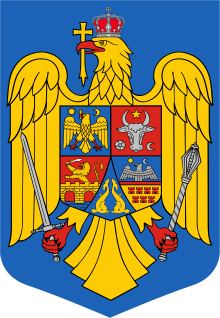 |
The golden aquila holding an Orthodox cross is the symbol of Latinity and a heraldic bird of the first order symboling courage. The shield on which it is placed is azure, symbolising the sky. The eagle holds in its talons the insignia of sovereignty: a mace and a sword, the latter reminding of Moldavia’s ruler, Stephen the Great whereas the mace reminds of Michael the Brave, the first unifier of the Romanian Principalities. On the bird’s chest there is a quartered escutcheon with the symbols of the historical Romanian provinces (Wallachia, Moldavia, Transylvania, Banat and Oltenia but also Dobruja). |
| |
.png) |
The military colors are the symbol of military honor, bravery and glory. They evoke the past struggle of the Romanian people for national liberty and the traditions of unity, reminding each soldier of his sacred duty to serve the Fatherland with trust, and to defend at all costs the unity, sovereignty and independence of Romania |
| |
 |
It commemorates the assembly of the delegates of the people of Transilvania held in Alba Iulia, which declared the Union of Transylvania with Romania. This holiday was set after the 1989 Romanian Revolution and it marks the unification of Transylvania, but also of the provinces of Bessarabia and Bukovina with the Romanian Kingdom, in 1918. Prior to 1918, the national holiday of Romania was set to be on May 10, which had a double meaning: it was the day on which Carol I of Romania set foot on the Romanian soil (in 1866), and it was the day on which the prince ratified the Declaration of Independence from the Ottoman Empire in 1877. In Communist Romania, the date of the national holiday was set to August 23 to mark the 1944 overthrow of the pro-fascist government of Marshal Ion Antonescu. |
| |
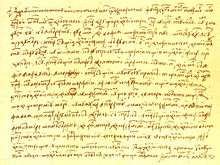 |
The main Eastern Romance language, spoken by around 24 to 28 million people |
Unofficial symbols
| Type | Image | Symbol |
|---|---|---|
| |
 |
The crown was forged from the steel of a gun captured by the Romanian Army from the Ottomans during the War of Independence (1877–1878). King Carol I of Romania chose steel, and not gold, to symbolize the bravery of the Romanian soldiers and was crowned with it during the ceremonies of the proclamation of Romania as a kingdom in 1881 in Bucharest.The Crown was again used in 1922 at the coronation of King Ferdinand I of Romania and Queen Maria of Romania as sovereigns at Alba-Iulia. The third time the Crown was used during the coronation and anointment of King Michael I of Romania by the Orthodox Patriarch of Romania, Nicodim Munteanu, in the Patriarchal Cathedral of Bucharest, on the very day of his second accession, September 6, 1940. The Steel Crown is kept in the National Museum of Romanian History |
| |
 |
According to the Romanian Orthodox Church, Andrew preached the Gospel to the Daco-Romans in the province of Dobruja (Scythia Minor), whom he converted to Christianity. There are some archaeological evidences for this tradition found in a cave called Basarabi, near Constanţa harbour, containing carved symbols of ancient Christianity. The Romanians have never been recordedly converted to Christianity as the neighboring nations, instead adopting the Orthodox Faith by themselves during the ethnogenesis process in an unorganized fashion. Having Apostle Andrew as a patron saint marks a special connection with the Ecumenical Patriarchate of Constantinopole and the political and religious heritage of Byzantium in the Romanian Principalities, metaphorically called Byzantium after Byzantium |
| |
 |
|
 |
| |
| |
 |
(Latin, "Nothing without God") used under the Hohenzollern-Sigmaringen dynasty |
 |
(Romanian, "All in one") used during the reign of Alexandru Ioan Cuza | |
 |
(Romanian, "Justice, Brotherhood") used during the 1848 revolution | |
 |
(Latin, "In Faith is the Salvation") used as the motto of the Order of the Star of Romania since 10 May 1887 | |
| |
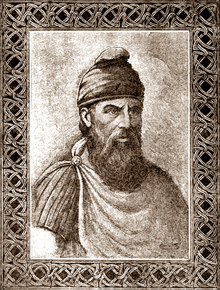 |
His name meaning "The Brave", Decebal was the last king of Dacia between 87–106 AD and is famous for fighting three wars and negotiating two periods of peace against the Roman Empire under two emperors, during which he continued to act as an independent king, rather than a conquered client and repeatedly annoyed or infuriated the Romans. Consequently, the Legions under Trajan's orders went on the offensive again in 105 AD, taking the Dacian capital city of Sarmizegetusa in 106, leading Decebal to commit suicide.Decebal is considered a national hero in Romania, a symbol of the Dacian origins of the Romanian people. |
 |
The Roman Emperor who conquered Dacia and brought the Latin element that together with the Dacian autochthons created the Romanian people | |
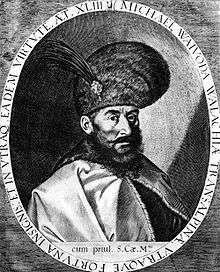 |
During his reign, the principalities of Wallachia (1593–1601), Transylvania (1599–1600), and Moldavia (1600) forming the territory of present-day Romania and Republic of Moldova were ruled for the first time by a single Romanian leader. He is regarded as one of Romania's greatest national heroes. | |
 |
| |
 |
| |
| |
|
|
 |
| |
 |
| |
| |
.jpg) |
|
 |
| |
 |
| |
| |
|
|
 |
| |
| |
 |
|
| |
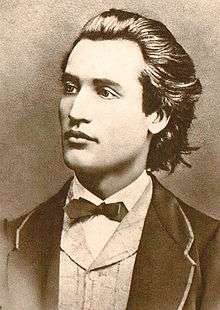 |
|
| |
 |
|
| |
 |
|
 |
| |
| |
 |
|
| |
 |
|
| |
 |
|
| |
|
|
| |
 |
|
| |
 |
|
| |
 |
|
| |
 |
|
 |
| |
| |
 |
|
| |
| |
| |
 |
|
 |
| |
 |
| |
 |
| |
| |
|
|
This article is issued from Wikipedia - version of the 10/19/2016. The text is available under the Creative Commons Attribution/Share Alike but additional terms may apply for the media files.